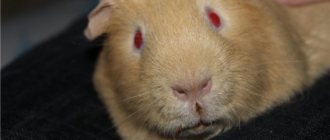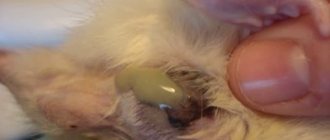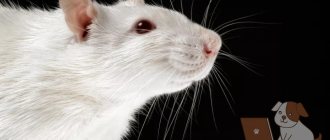- home
- General information
18.07.2018
Unfortunately, tumors in hamsters are not uncommon. This is especially true for animals over two years of age. If you find a lump on your pet's neck, belly, back, side or paw, try to find out the cause. The lump may be hard or soft, painless or painful when touched. In any case, the baby needs urgent treatment.
A tumor is not always oncology
If you find a lump on your pet’s body, don’t be alarmed right away. There are many causes of tumors; they are not always malignant. The final diagnosis can only be made by a doctor, preferably a ratologist - a specialist in rodents.
- A lump in the neck may be an enlarged lymph node. The animal eats poorly and has difficulty turning its head. The inflammatory process occurs in the lymph nodes if there is an infection in the body. It is necessary to find out the cause and begin treatment, otherwise the inflammation may develop into an abscess.
- A tumor on the abdomen is most often caused by a problem with the mammary gland. Frequent childbirth negatively affects the health of females.
- If your cheek is swollen, it may be due to inflammation of the cheek pouches or dental problems.
- Growths in the ear can occur as a result of otitis media, an inflammation of the middle ear. These formations are filled with pus and emit a bad odor. The disease is treated with antibiotics.
- Sometimes dense warts appear on your pet's body. These are papillomas - benign formations caused by a viral infection called papillomatosis. Usually, papillomas disappear on their own as soon as the body copes with the infection.
- Swelling on other parts of the body may be the result of fights with other cage inhabitants or other injuries.
- Beginning hamster breeders often mistake the male scent glands for a sore. These organs are covered with a yellowish crust and look like a growth. The Djungarian hamster has one gland, the Syrian hamster has two on the sides of its abdomen.
What infections are contagious to humans?
Scab, ringworm and dermatophytosis have a detrimental effect on the human body, causing almost the same symptoms as in animals. Therefore, if you are treating your pet at home, you need to protect yourself and all family members. Be sure to wear disposable gloves when performing treatment procedures. Objects that the sick animal has come into contact with must be treated; if possible, it is better to boil them.
People with weakened immune systems and prone to frequent stress are often susceptible to these infections; children most often suffer from dermatophytosis.
Diagnostics
An infection can only be diagnosed by taking tests in the form of scraping from the affected areas to determine the fungus.
Abscess in a hamster
An abscess in a hamster is a purulent formation under the skin. This place on the body becomes red and swollen, and it is painful to touch. Gradually the cavity fills with pus. There is something liquid under the skin. Often hair falls out at this place. An abscess can occur as a result of injury to any part of the body: back, side, stomach or butt. The reason may be a fight with other inhabitants of the cage, poor-quality attributes and exercise equipment with sharp corners, which can injure the rodent.
What to do in this case. Treatment consists of taking antibiotics and treating the sore spot. The abscess is opened, the wound is cleaned and treated with hydrogen peroxide, the edges are smeared with brilliant green. If the abscess is not treated, the abscess will eventually burst on its own and leak pus. The wound also needs to be cleaned and treated with an antiseptic. Levomekol or preparations from the Fitoelita series are used as a healing ointment. The cage and all objects in it must be disinfected. Repeat wound treatment daily to prevent new infections. An untreated abscess can turn into a fistula, and this will require surgical intervention.
Product Features
Eggs contain elements that have a beneficial effect on the health and condition of the body. They contain the following components:
- Proteins.
- Squirrels.
- Vitamins of groups A, E, D, K.
- Carbohydrates.
- Minerals (potassium, calcium, magnesium, iron, etc.).
All these components are easily absorbed in the human and animal body. They have beneficial properties and charge you with the necessary energy. Hamsters can be given eggs in moderation.
The egg consists of white and yolk. The first element contains 90% water. The remaining 10% consists of proteins, glucose, vitamins, and enzymes. The yolk consists of organic substances - fats, minerals, vitamins. The yolk is the most useful element. It has a beneficial effect on the growth, health, and development of the hamster. It is recommended to feed the animal with both components.
Do not doubt whether hamsters can have a boiled egg. As a supplement to food, it is necessary.
The product helps strengthen bones, normalize the functioning of the liver and digestive organs. Has a beneficial effect on the nervous system and the course of pregnancy. Helps prevent the development of tumors.
What to do if your hamster has a swollen paw
If your hamster's foot is swollen, it may be a closed fracture. Even if you take a picture, no one will put a cast on the baby. The only thing a caring owner can do is to put the poor thing in a container for carrying rodents with smooth walls without rods and create more comfortable conditions for him. Place soft paper towels on the floor instead of filler. Provide enhanced nutrition and vitamins, monitor the condition of the injured limb. If a wound or abscess opens, they need to be treated with an antiseptic daily.
In rare cases, a tumor on the paw may be malignant. Then the owner will no longer be able to help the pet.
Useful properties and composition of eggs
This is a complete nutritious product, the protein of which is easily absorbed by the body. Therefore, its usefulness for hamsters is obvious. In addition to protein, eggs are rich in proteins, carbohydrates, minerals and vitamins. It is perfect for feeding hamsters.
In addition, eating this product will improve the functioning of the liver and nervous system, prevent cancer, and help your pet feel cheerful and healthy. Pregnant females are assisted in the proper development of the fetus.
Be sure to include a boiled egg in your diet, which consists of white and yolk. Protein contains water (90%), vitamins, glucose, carbohydrates, and various enzymes (10%). The yolk contains organic substances - fats, minerals (iron, calcium, magnesium, potassium, sodium and others) and vitamins (A, D, E and K). This part serves as the only nutritional element for the embryo for normal development and growth. The yolk is most useful as food for rodents. You shouldn't give up protein either.
When purchasing, do not forget to look at the expiration date so that the product is not expired and so as not to poison your pet.
Why does a hamster have big testicles?
Sometimes a caring owner, having discovered that the male has large testicles, begins to seriously worry whether the pet is sick. But large testicles are normal for rodents. They usually become noticeable at the age of two months.
Sometimes the male has one large lump in the lower abdomen. This can also scare the owner. But this happens if one testis does not exit into the scrotum, but remains in the abdominal cavity. This phenomenon is called unilateral cryptorchidism and does not require treatment.
In older animals, pathologies of the testes are often found. If the animal's eggs are swollen, this may be a sign of infection. Typically, during the inflammatory process, redness is observed, the testicles become hot to the touch. Treatment consists of taking antibiotics prescribed by your doctor.
In oncology, one testicle is usually affected. In this case, the only way to save the baby’s life is by castration. If there are males and females in the same room, but in different cages, this may also be the reason for the increase in the size of the testicles in the male. The testes collect seminal fluid, the hamster is ready to reproduce, but there is no outlet for his sexual instinct.
Determination methods
There are several methods to determine the sex of a Djungarian hamster
The sex of a hamster can be determined when the animal reaches three to four weeks of age. If the hamster is already an adult, there should be no problems with sex determination. But if puberty has not yet occurred, it is worth trying the following methods.
First you need to secure the hamster. two ways to do this .
- We need the hamster to spread its hind legs and let us see its genitals. To do this, with clean hands, carefully grab it by the scruff of the neck and lift it, the hamster will stretch out, and it will be easier to establish its sex.
- The second method is much preferable because it causes less anxiety and discomfort to the animal. So, you can place the hamster on your palm with its belly up and hold it with your thumb. Under no circumstances should you squeeze the body of your cute rodent too tightly; you need to handle it very carefully, identifying the animal’s sexual characteristics with your free hand. Stroke the hamster's belly a little to calm it down, caress it, because with caress you can achieve much more from an animal. And the pet will know that you can be trusted and you will not harm him.
When is surgery necessary?
If your pet does have a tumor, and the doctor confirms the disappointing diagnosis, the only option left is surgical removal. There is no point in delaying the operation; diseases in dwarf hamsters and other breeds of hamsters progress very quickly. As long as the hamster's tumor is small, it will be easier to undergo surgery. Removing the affected organ may, if not completely cure the animal, then at least prolong and make the rest of its life easier.
An experienced doctor will perform the operation under inhalation anesthesia. The use of such anesthesia has recently increased the percentage of successful operations to remove tumors in decorative rodents.
Diseases of the skin, fur and claws
Alopecia
There are many reasons for hair loss that is not associated with seasonal shedding in animals.
Usually this:
- stress;
- lack of nutrients;
- inflammatory diseases of the gastrointestinal tract;
- parasitic and fungal infections.
For any reason of illness, the animal needs to ensure a quiet existence, harmonize and fortify the diet.
In case of ringworm or parasitic infections, specific treatment is required.
Dermatomycoses
Most often these are microsporia and trichophytosis. With fungal infection of the skin and fur, the animal not only loses its hair, the hairs look broken at the root, sores and crusts appear on the skin. The animal is bothered by severe itching.
Dermatitis
Hamsters can have an allergic reaction, for example, to bedding. It is manifested by skin itching, tissue hyperemia, the appearance of various elements of the rash, and scratching.
Parasites
Helminthiasis can lead to deterioration in wool quality. Parasitism of lice and fleas leads to skin itching, tissue damage, and the formation of tangles.
Mouse pox
This disease is more common in rats and mice, but sometimes hamsters are also infected. In the acute course of the disease, the animal dies with minimal symptoms. With a less pronounced process, the hamster’s paw swells, closer to the sole, and blisters form on the skin. The paw hurts greatly, the process ends with gangrene and loss of the limb.
Other diseases
Herpes
In hamsters, this viral infection is practically asymptomatic. Usually after 1-2 weeks the animal’s immune system suppresses the activity of the virus. Treatment is rare.
Plague
It occurs with severe exhaustion of the pet, its fur is disheveled, has an unkempt appearance, the skin and visible mucous membranes are cyanotic. Rodents usually die.
Tuberculosis
May occur with respiratory (slight cough and shortness of breath) or abdominal (diarrhea, lack of appetite) symptoms. The animal loses weight, its fur becomes unkempt. It is recommended to destroy the carcasses of dead animals.
Brucellosis
Symptoms are mild. In males, the testes may become inflamed. Pregnant females experience self-abortion and inflammation of the myometrium.
Leptospirosis
The main symptom of this disease in a hamster is considered to be a dysfunction of the vestibular apparatus.
Tularemia
In hamsters, the disease occurs without specific symptoms. The animal may die. It is not recommended to touch an animal that is sick or has died from tularemia without protective equipment, in order to avoid infection.
Diseases that cause symptoms of a nervous disorder
Encephalitis
The disease is accompanied by paresis and paralysis. The process develops at lightning speed. During the first 2 days, the hamster may die.
Rabies
An infectious disease that is fatal to a hamster, regardless of its breed. Caused by rhabdovirus.
Main signs: hydrophobia, aggression, ruffled fur, refusal to eat and drink.
False rabies
Aujeszky's disease is a viral infection that attacks the nervous system of a hamster. The disease begins with skin symptoms (itching, scratching). The animal is restless and loses its voice. In an untreated state, the hamster experiences paresis and then paralysis of the larynx.
Injuries and tumors
Spinal fractures and spinal cord tumors lead to paresis and paralysis of the limbs, the animal’s inability to move, and spontaneous excretion of feces and urine. And other symptoms associated with the site of injury (impaired breathing, cardiac activity, etc.)
Metabolic disorders
Do you know what hamsters get sick with besides viral, fungal and cold infections? Some individuals experience metabolic disorders. Sometimes they are hereditary, but sometimes humans are also to blame, as is the case with diabetes mellitus among the Djungarians.
Diabetes
Interestingly, the symptoms of diabetes in hamsters are the same as in humans:
- irrepressible thirst and increased appetite;
- sharp fluctuations in weight (quickly losing weight or getting fat);
- physiological fluids smell like acetone (urine, saliva);
- increased interest in the wheel: the animal is able to spin it longer than usual without stopping.
Diabetes mellitus is diagnosed using a laboratory blood test - checking glucose levels. After the diagnosis is established, drug treatment and a diet with a high protein content and a small amount of “fast” carbohydrates are prescribed.
Stroke
Metabolic diseases also include vascular diseases that occur in old age. Stroke in hamsters is often caused by the deposition of cholesterol plaques in the vessels of the head (that is, lipid metabolism is impaired). When the plaque completely covers the lumen of the vessel, blood accumulates, and the walls of the vein or artery stretch under its pressure. But they cannot stretch forever, the vessel bursts and hemorrhage occurs.
Stone disease
Stone disease is a very dangerous condition for hamsters. It occurs when salt metabolism is disrupted, as a result, sand gradually accumulates in the kidneys, bladder and bile ducts, combining into pebbles. When the stone moves, it causes hellish pain, the hamster screams heart-rendingly. Also, with this disease, the hamster's tail is tucked, the animal rarely pees, and there is blood in the urine. In small rodents the disease is not treated.
Obesity
In nature, hamsters are in a state of perpetual motion. And in our home they are often deprived of many active activities. There is a particularly high risk of decreased activity due to obesity, which can lead to even more dire consequences. After all, obesity is the first path to cardiovascular diseases and muscle atrophy. To avoid problems, carefully monitor your pet’s diet and make sure that his cage has enough “horizontal bars” for exercise: a running wheel, ladders, free space, tunnels. Let the animal out for a free run more often, the main thing is to carefully ensure that it does not run anywhere and get hurt.
Obesity, like urolithiasis, is typical for mature hamsters. It occurs infrequently in active dwarf hamsters (unless accompanied by diabetes); Syrian hamsters have a greater predisposition.
The photo shows an obese hamster.
Polycystic ovary syndrome
Polycystic ovary syndrome is a hormonal disorder in hamsters. The main cause of hormonal imbalances is frequent childbirth. At the same time, the hamster becomes lethargic, irritable, and her tummy is slightly swollen, bowel movements are irregular. It is possible to cure a female, but it cannot be done without surgery.
Hormonal changes coupled with poor nutrition can cause hemorrhoids in a hamster. This is a painful condition in which it is painful for the animal to defecate; in the hamster, blood can be seen on the fur under the tail.
Prevention
Most diseases occur due to unbalanced nutrition and uncomfortable living conditions. You should feed the hamster with ready-made food mixture from the store, adding a little carrots or cauliflower. The animal will happily eat human food - bread or cheese, but such treats most often do harm, undermine the immune system and become the cause of many diseases, including the tumor process. The rodent should not be bathed. He can't stand drafts.
Satiety and fun are the best prevention
So, let's try to figure it out - is there an allergy to alcohol?
Internal ethyl alcohol is a compound necessary for metabolism and energy, which regulates the permeability of cell membranes and helps the body adapt to stressful situations. So can you be allergic to internal alcohol? In fact, no, because it is the “brainchild” of the organism itself.
More often, allergies occur from alcohol taken orally. Theoretically, such reactions of the body are possible to all types of alcoholic products.
It is difficult to say when the first alcoholic drink appeared, perhaps at the same time as the first dishes. Our distant ancestors created the first varieties of wine and beer from grapes, honey and fruits.
Pure alcohol was obtained by alchemists in the Middle Ages and was called “alcohol,” which means “intoxicating” in Arabic. Did you already have an allergy after drinking alcohol? History is silent about this, but modern alcoholic drinks quite often become the cause of allergies.
There are allergies to preservatives, dyes, hops, tannins, malt, flavorings, yeast, wort and other substances that are used in the production of alcoholic beverages. The most “allergenic drinks” are considered to be cognac, beer, liqueur, wine and vermouth.
It is safe to say that the cheaper the alcohol purchased, the higher the risk of an allergic reaction due to the large number of dangerous additives.
Substances used to protect plants from parasites and fertilizers for a better harvest, if they get into plants, can cause an allergy to alcohol.
Allergens from fruits and berries from which the alcoholic drink is made also cause symptoms in people with food allergies.
Attention!
The rapid removal of ethanol breakdown products from the body with the help of Enterosgel sorbent will help avoid allergies from alcohol and alcohol poisoning.
Many organic (and inorganic) substances can enter alcoholic beverages during the technological process. It is from them that signs of skin allergies and digestive disorders appear.
By the way…
Ethanol is a good solvent for various substances that, when entering the body, begin to manifest their “allergic essence”. In other words, ethanol increases allergies. Moreover, alcohol can be very dangerous if you have allergies!
Ethyl alcohol also accelerates the absorption of allergens that enter the body with various products. It has been established that ethanol contributes to the occurrence of nutritional allergies in 12% of patients. A red face, rashes on the legs, torso and arms after drinking alcohol are quite common manifestations among allergy sufferers.
In addition to alcoholic beverages, ethyl alcohol is included in various medicines, hygiene and cosmetic products - because of this, allergic reactions often occur to them.
Alcohol and pregnancy
Drinking alcoholic beverages by a pregnant woman in the future provokes allergic diseases in children - asthma, dermatitis, rhinitis, and so on.
Respiratory diseases
Trichomoniasis
This is an infectious disease characterized by the formation of yellow plaque and swelling of the pharynx, respiratory failure and laryngospasm. This condition leads to difficulty both breathing and eating. The hamster is losing weight and may fall.
Lymphocytic choriomeningitis
An infectious disease in rodents that cannot be treated. When this pathology is diagnosed, it is recommended to euthanize the animal.
The disease manifests itself:
- increased body temperature;
- breathing problems;
- lethargy and weakness of the pet.
The main carriers of the pathogen are mice and rats. Therefore, if the animal is kept in a room attacked by mice or on the street, it is necessary to make it difficult for mice and rats to access the hamster's cage.
Respiratory infections
The influenza virus and other respiratory infections can be transmitted from hamsters to humans and back. The disease is accompanied by sneezing, coughing, lacrimation, and rhinitis. The disease can develop against the background of hypothermia or severe stress.
Diplococcal infection
This disease occurs with high fever, severe rhinitis, wheezing, cough, and loss of appetite. The animal loses weight, visible mucous membranes become pale. A few days later the hamster dies.
Infectious pneumonia
A bacterial infection that occurs with loss of desire to eat, inability to move, and difficulty breathing. At the same time, the hamster’s mucous membranes acquire a bluish tint, he coughs, gurgling is heard in the lungs, and conjunctivitis develops.











